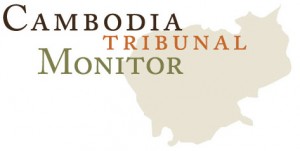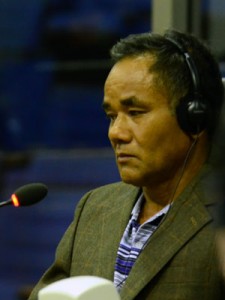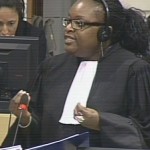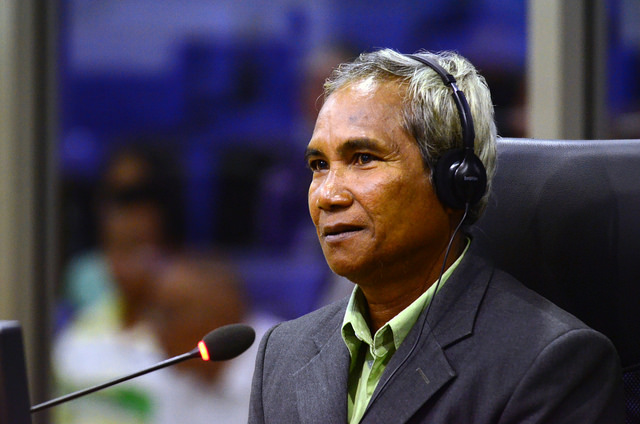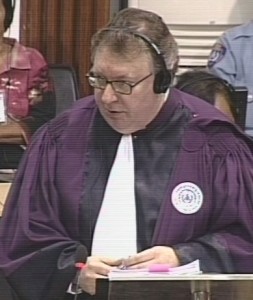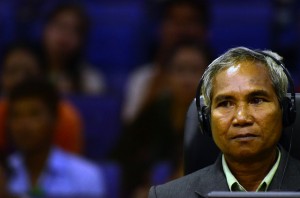“I Refuse To Answer The Question”- Witness On Whether He Inflicted Corporal Punishment
Today, on August 11, 2015, the Trial Chamber continued to hear witness Mr. Kan Thol (or Thorl). You can read yesterday’s examination of Mr. Thorl by the prosecution and the civil party lawyers here.
The hearing started with questions from Judge Lavergne about Mr. Thorl’s testimony that he was afraid of being taken away and killed if he dared refuse any instructions. Although Mr. Thorl said he never witnessed any arrests he was afraid of being arrested because he heard it from other people as a rumor.
Judge Lavergne asks if this meant that this fear was shared by everyone and Mr. Thorl responds that yes that is true.
Judge Lavergne asks about the spies Mr. Thorl had mentioned that would come at night to watch over him. Mr. Thorl repeats that he did not know them.
Mr. Thorl kept insisting that he had no knowledge about political training sessions or any arrests.
Mr. Thorl then said, contradicting his testimony from the day before, that he was one of the “17 April People.” Judge Lavergne explains that that cannot be true as Mr. Thorl was never evacuated.
Mr. Thorl, curtly, confirms that Lon Nol Soldiers were persecuted. “If the person was found to have a military rank, that person would be called to a study session.” Thorl does not know what happened at the study session soldiers as there were no cases in his area, he says.
Thorl also says that there were no Cham people in his area.
Thorl then said that he had heard that any Vietnamese that was found would be sent away and executed. He said it was word of mouth, “everybody knew about it in the mobile unit,” he said.
Thorl confirmed the existence of the “special case” unit, that had to work full time during the day. Thorl tells that people with night-vision problems would be placed in the “special case” unit. He says that there was a test whereby people were made to walk past a hole were all the boiling water from the rice had been poured during the day and if they fell in, they would be put in the “special case” unit. Thorl does not know if they had a higher work quota.
Judge Lavergne asked about the “imaginary sick” people or the people who became “consciously ill”, that is, that they faked their illness at the worksite so they would not have to work. In a bizarre response, at least in the translation, Thorl explained that the medics knew who was faking his illness at the moment they talked to other people. When it was found that someone was “consciously ill” that person would be immediately sent to a re-education meeting so they would not do it again. Their food ration was reduced if they kept doing it again, Thorl explained.
Thorl says that no one died at the worksite. After workers were sick for more than five days, they were sent to the commune hospital, he says. Thorl confirms that some died in the hospital.
Judge Lavergne finishes his questions by asking about the Chinese delegation that had visited the Dam. Thorl does not recollect the date of the visit but recalls that Ta Nhiem accompanied the delegation. He sais that at that time a film was screened. The film mentioned Ta Tsai who demolished a mountain and turned into a rice paddy.
Thorl says he has seen pits that were used to bury people that were executed. He says he saw them in the eastern part of the TT Dam worksite and the other place where he saw them was by the roadside. Thorl says that there were not many corpses in these pits; he says there were about three people in one of them.
With that the floor is handed to Mr. Koppe, lawyer for Nuon Chea.
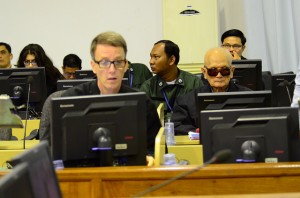
Mr. Koppe, lawyer for Nuon Chea, sitting in front of his client (in the sunglasses), who rarely attends Court because of back pain.
To Koppe, Thorl confirms that he knew he started working on the 14th of February of 1977 because before he left for the construction of the Dam, he was told he had to be there on the 10th of February, then rest for three days while they built their shelters, and then start work on the 14th. Thorl says that the construction was completed on the first day before the Khmer New Year.
Koppe reads a statement where it was reported that Ta Nhim had said, at the worksite, that the Dam was built in less than two months, and hold that 150 million cubic meters of water and irrigates over 7,000 hectares of rice fields. After 4 years, it will expand to hold 300 million cubic meters of water. There was a drought at the beginning of the work and the 20,000 workers did not have enough water. “One could not help but admire the Kampuchean people for their zeal… Now rice is growing well everywhere.” Thorl does not remember the statement but then he says that he remembers Nhim saying that there were 15,000 workers.
Thorl does not know whether Heng, whom he had mentioned yesterday, was called Brother number 7 or whether he was arrested nor what his real name was. Thorl also does not know whether Ta Val or Ta Chil or Ta Nhim were arrested.
Koppe continued to ask Mr. Thorl about events that Thorl had no knowledge about and Thorl kept repeating that he did not know or had not heard about it.
Thorl speaks about a person who died at the hospital, blood running down his nose, because of a “spirit issue” a superstition in Cambodia, he says. Mr. Koppe asks if his death then had nothing to do with his work, and Thorl confirms that that is correct.
Koppe asks if it is still possible to drink water from the streams in his region, as was done during the building of the TT Dam, and presumably one of the the reasons why workers got sick. Boyle objects on the ground that the witness can only speak to his own knowledge. Koppe reformulates to ask if he forbids his children from drinking water form the ponds and streams in his region. Thorl confirms that he does but in the past it was common to drink water from the ponds and streams.
The floor is then handed to Anta Guissé, co-international defense lawyer for Khieu Samphan.
Thorl confirms that as deputy chief he did not set different working schedule or different rations for the “17 April People” as compared to “Base People.”
When asked if he received instructions to inflict corporal punishment or whether he himself inflicted corporal punishment, Thorl said he declined to answer the questions and exercised his right to remain to be silent. While Guissé moved on, the prosecution rose to ask that it be clarified whether Thorl is doing so on the basis that he does not want to self-incriminate himself as that is the only grounds on which he can refuse to answer a question. The Bench took refuge in that the witness had already be read his right and that he could remain silent but did not address the substance of the prosecution’s observation.
Mr. Thorl explained how they used the bamboo stick to measure the amount of earth that people had to carry each day. The plots might start at ½ meters deep and be 2 meters long. He said that the chief might help a group and he, the deputy chief ,might help another group with their quota.
Thorl confirms that the shifts during the 5-day 24-hour work schedule that Thorl had mentioned yesterday, were for different people. He explains that people would alternate in three groups.
Guissé asks about medicine before the CPK, Thorl explains how there was traditional medicine and normal medicine and people could choose.
Guissé gets Thorl to admit that he never witnessed any arrests of Vietnamese persons. He also did not hear about any border conflicts with Vietnam throughout the CPK period.
Guissé ends the examination by asking a leading question of whether Thorl had told Judge Lavergne things he had not witnessed like the “special case” unit. Thorl admits that he never saw them but everyone spoke about them.
After a few questions from Kong Sam Onn, co-lead national lawyer for Khieu Samphan, the Court breaks for lunch.
Trol explains to Mr. Onn that he did not mean that the “consciously ill” were found to be faking their illness because they were talking to one another, as he had said to Judge Lavergne, but that he had said that they were playing with each other, such as poking each other.
__
After Lunch, the Chamber heard witness Mr. LAT Suoy, 55, who was accompanied by a duty counsel.
Mr. Suoy is currently a rice farmer. His father’s name is LAT Nu and Nab Khoun is his mother’s name. He has six children with wife Dam Ret.
He said he was interviewed twice by the OCIJ. One in his commune, Prah Met Preah, and once in the court, he says.
The floor was given to the prosecution in the hands of Mr. Dale Lysak.
Background
Mr. Suoy became a Khmer Rouge soldier when he was 15-years old. He said that it was an “absolute requirement” to join the army. “I did not even understand what it was all about,” Suoy said, “Then they took me into the jungle. I was always crying in the jungle because I missed my parents and my relatives.”
Suoy says that they did not explain what “absolute” or “absolutes” meant. He says that he did not understand at that time what it was about.
Suoy said he was in Regiment 513. “Afterwards they recruited the ‘absolutes’ “!7-April People’” and the Battalion was divided up in mid-1975. “I was assigned to the district military of Phnum Srok,” he said. His new unit consisted of 90 members.
The commander was Ta Chum. Ta Nak was the deputy commander.
Execution of Lon Nol Officials
Suoy said that former Lon Nol soldiers were taken away and executed. “I was very worried myself,” he said, “because I was from one of the intellectual families so I thought I would be eventually killed. At that time they would kill anybody who was educated. “
In his family, his relatives had studied until grade one or two (probably in the old Cambodian system, which is in reverse) and they would not call themselves intellectual but they had received some education.
“I only heard from others that they were killed. They arrested them and then they disappeared,” he added. He says he remembers a man named Ruos (phonetic) that was arrested and executed and his wife was executed too. He adds that he was very young at the time and only tended the cattle.
Objections
When Lysak attempts to ask about his time as a guard at a jackfruit plantation and what were his orders, Kong Sam Onn objects.
Kong Sam Onn objects because the facts that are being testified to may have occurred before April 17, 1975 and because allegedly the killing of Lon Nol soldiers is limited to Tramkok.
Mr. Lysak responds that it is clear that it is after 1975 and secondly that the prosecution has insisted and will continue to insist that this a systematic and country wide persecution of Lon Nol soldiers, notwithstanding that the defense disputes it.
Koppe jumps in and says that the closing order limits the persecution of Lon Nol official to Tramkok District, TT Dam and S-21 (he would later add that the closing order also mentions Kraing Ta Chan prison).
Lysak responds that the the policy was implemented simultaneously in every region of the country where people with connection with the Lon Nol Regime were rounded up.
The Chamber deliberates and rejects the objection because the purge at TT Dam is part of the evidence of a national policy.
Koppe insists that its in the closing order, notwithstanding that his microphone is turned off. He reads a part of the closing order, I believe, where it says that it is limited to those four sites mentioned above. He says he maybe is not understanding the Bench’s decision.
President Sokhan tells Koppe that the matter has been ruled on.
Marie Guiraud, nevertheless stands up and says the policy has to de demonstrated at the national level. The President allows the prosecutor to continue but Mr. Onn objects again but then only asks for a geographical location which the witness gives.
Guard at TT Dam
Lysak moves on to asking him about the time he was a guard at TT Dam. The witness Suoy said he was there for one-month. He says he was there when the construction was concluded. He puts the date of completion sometime around late 1976 or early 1977. Lysak says he might come back to clarify those dates.
He was part of a ten-man group that guarded the Dam. The team chief was Phan. Above Phan was Ta Nak, whom he had mentioned earlier. He was assigned to be a guard on the first bridge, close to which parts of the Dam were broken.
Ta Val
Suoy remembers that Ta Val was the head of all units at the TT Dam, which seems to corroborate other testimony and the closing order. Suoy says he came to know Ta Val well as he was part at one time of the Sector force and he also lived at the same place as Ta Val. “He actually selected me to be a part of the absolute unite and that is why I stayed near where he stayed,” he said.
Suoy clarified that he did not attend Ta Val’s marriage ceremony but he heard about it through his colleagues. He said that he thinks the marriage was arranged. He remembers that at that time Ta Val was 52 or 53 years old.
Suoy said he saw Ta Val come in the morning to inspect the workers. Sometimes he came every day or sometimes every two or three days, Suoy testified.
Suoy also says that Ta Val was a very strict person and people at the worksite were afraid of Ta Val “Every time Ta Val came, everybody was afraid of him and they worked harder,” Suoy said. “I was afraid of him too, I dared not look at his face,” he added.
Arrests
Arrests at the worksite were carried out by Ta Val’s subordinates. “Some workers committed some mistakes” and they were reported to Ta Val. “Ta Val made the order for the arrest and the killing,” he said.
Suoy said that he heard this from on of the subordinates of Ta Val.
Suoy mentioned that Chuoy, who had a connection with the Lon Nol Regime, was arrested and disappeared. He learned this because he remembers that Chuoy was a former soldier around 20-years old but he had lied to them and had said he was an orphan and had grown up in a pagoda.
Fleeing
Suoy confirms that people fled from the Dam but his unit was not in charge of arresting them. He says the village security was the ones who arrested the ones who fled.
His OCIJ statement says that sometimes he received orders to arrest someone who was fleeing. “Sometimes I caught them and sometimes I didn’t,” he said.
In his DC-Cam statement, he says that “even after the arrests we could not kill them. We sent them over to the superiors to deal with them.”
Suoy confirms both statements. Souy did not have a full understanding of the killing at the TT Dam, as “our duty did not have to deal with that. We were assigned to stand guard and if we disobeyed we would risk our lives.”
Walking beside the pits
Suoy confirms Thorls’ testimony (prior witness) of the test that people who claimed they had night-blindness, to avoid night work, were put to. People were told to walk beside the pits at night and if they fell in they would be allowed to rest.
The DC-Cam statement in English says that “those pits would result in death if you fell into them. If the person did not fall into them, the accompanying person would push that person in to the pit.”
“I saw it,” he says in the DC-Cam statements as read by Lysak, “the killing of people were not done by troops but by the chiefs of battalion, regiment and company.”
Onn and Koppe object because the original in Khmer does not say that it would result in death if you fell in into those pits. The witness clarifies that the pit’s depth was about one meter and people would not die if they fell into the pit. They would get injured but no one died, he said.
Suoy says that if workers “actually fell into the pits they would be allowed to rest. If people repeated this imaginary sickness, they were taken away and killed.”
He then says, contradicting what he had said before, that people who actually had night blindness would be stopped form falling in. People who lied about their sickness, on the other hand, would be pushed in. After falling in, they would be sent for “re-fashioning.” If they could not be refashioned or if they repeated the claim that they had night-blindness they would be dealt with, Suoy says. When pressed, Suoy says that the solution for these people was to kill them.
TT Dam working conditions
Suoy confirms that the special unit only had one-hundred members. “There were female members who served in the special unit and were entitled to one can of rice per day for the food ration for them,” he said.
Suoy confirms his DC-CAM statement where he had said that “workers at the Trapeang Thm Dam were emaciated…For some, their knees were bigger than the heads.”
Suoy confirms there were swarm of flies and mosquitos at the worksite. “At night, if we did not have mosquito nets, we were bitten a lot,” he said.
NW Zone purges
Suoy remembers that he was told that they would arrest the NW zone cadres and they took them to a meeting and the SW Zone cadres arrested them. He said that Ta Nak told him.
Koppe objects on the grounds that there was not wave of arrests after the SW zone cadres arrived, as the first NW zone cadres were arrested almost one year before the last one was arrested.
Lysak replies that “counsel [Koppe] is not here to give evidence and I can say that he is wrong, there was a wave of arrests as detailed in S-21 records.”
The President overrules the objection.
Mr. Suoy remembers of Heng, Vat, Mang and Ta Val’s arrests and how they disappeared afterwards.
Lysak reads from S-21 documents that say they were arrested in some point in mid 1977, possibly in June of that year (26, 27 and 28 of June). Suoy says the arrests took place quite close to one another.
Ta Nak, his superior, Suoy says, was also arrested and disappeared.
Suoy says that he fled to his house after they arrested his superiors but the SW cadres still arrested him.. He was sent to Prey Sprea commune but managed to escape. “At that time I used traditional martial arts and I knocked the guards down and was able to flee,” he says.
The court adjourns and will resume tomorrow.
